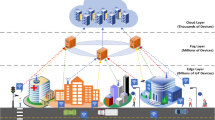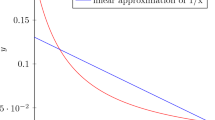Abstract
Homomorphic encryption is a significant method to protect user privacy in cloud computing environment. Due to the computation efficiency issue, there is still not many homomorphic encryption applications for common users. In this paper,we try to use homomorphic encryption to enhance the privacy in cloud-based face recognition system. By balancing the workload between client and server,and reimplementing the similarity measurement function, our homomorphic encryption version’s performance is almost the same as the original version in terms of accuracy and time consumption. Our work is especially beneficial to many face recognition methods that are using Euclidian distance as their similarity metric.






Similar content being viewed by others
References
Barni M, Orlandi C, Piva A (2006) A privacy-preserving protocol for neural-network-based computation. In: Proceedings of the 8th workshop on Multimedia and security, pp 146–151
Bos JW, Lauter K, Loftus J, Naehrig M (2013) Improved security for a ring-based fully homomorphic encryption scheme. IMA international conference on cryptography and coding. Springer, Berlin, pp 45–64
Brakerski Z (2012) Fully homomorphic encryption without modulus switching from classical gapsvp. Annual cryptology conference. Springer, Berlin, pp 868–886
Brakerski Z, Gentry C, Vaikuntanathan V (2014) (Leveled) fully homomorphic encryption without bootstrapping. ACM Trans Comput Theory (TOCT) 6(3):1–36
Cao Q, Shen L, Xie W, Parkhi OM, Zisserman A (2018) Vggface2: A dataset for recognising faces across pose and age. In: 2018 13th IEEE international conference on automatic face and gesture recognition (FG 2018), pp 67–74. IEEE
Cheon JH, Kim A, Kim M, Song Y (2017) Homomorphic encryption for arithmetic of approximate numbers. International conference on the theory and application of cryptology and information security. Springer, Berlin, pp 409–437
Dadi HS, Pillutla GM (2016) Improved face recognition rate using hog features and svm classifier. IOSR J Electr Commun Eng 11(4):34–44
dlib c++ library. http://dlib.net (2020)
Failla P, Barni M, Catalano D, Raimondo MD, Bianchi T (2010) A privacy-compliant fingerprint recognition system based on homomorphic encryption and fingercode templates. In: IEEE international conference on biometrics: theory applications systems
Fan J, Vercauteren F (2012) Somewhat practical fully homomorphic encryption. IACR Cryptol ePrint Arch 2012:144
Faruqe MO, Hasan MAM (2009) Face recognition using pca and svm. In: 2009 3rd International Conference on Anti-counterfeiting, Security, and Identification in Communication, pp 97–101. IEEE
Gentry C (2009) Fully homomorphic encryption using ideal lattices. In: Proceedings of the forty-first annual ACM symposium on Theory of computing, pp 169–178
Halevi S, Shoup V (2014) Helib-an implementation of homomorphic encryption. Cryptology ePrint Archive, Report 2014/039
He K, Zhang X, Ren S, Sun J (2016) Deep residual learning for image recognition. In: Proceedings of the IEEE conference on computer vision and pattern recognition, pp 770–778
Huang GB, Ramesh M, Berg T, Learned-Miller E (2007) Labeled faces in the wild: A database for studying face recognition in unconstrained environments. Tech. Rep. 07-49, University of Massachusetts, Amherst
Kotropoulos C, Tefas A, Pitas I (2000) Frontal face authentication using morphological elastic graph matching. IEEE Trans Image Process 9(4):555–560
Lades M, Vorbruggen JC, Buhmann J, Lange J, Von Der Malsburg C, Wurtz RP, Konen W (1993) Distortion invariant object recognition in the dynamic link architecture. IEEE Trans Comput 42(3):300–311
López-Alt A, Tromer E, Vaikuntanathan V (2012) On-the-fly multiparty computation on the cloud via multikey fully homomorphic encryption. In: Proceedings of the forty-fourth annual ACM symposium on Theory of computing, pp 1219–1234
Morampudi MK, Prasad MVNK, Raju USN (2020) Privacy-preserving iris authentication using fully homomorphic encryption. Multim Tools Appl 79(2)
Parkhi OM, Vedaldi A, Zisserman A (2020) Deep face recognition
Schroff F, Kalenichenko D, Philbin J (2015) Facenet: A unified embedding for face recognition and clustering. Proceedings of the IEEE conference on computer vision and pattern recognition, pp 815–823
Microsoft SEAL, (release 3.5). https://github.com/Microsoft/SEAL (2020) Microsoft Research. Redmond, WA
Stehlé D, Steinfeld R (2011) Making ntru as secure as worst-case problems over ideal lattices. Annual international conference on the theory and applications of cryptographic techniques. Springer, Berlin, pp 27–47
Sun Y, Liang D, Wang X, Tang X (2015) Deepid3: Face recognition with very deep neural networks. arXiv preprint arXiv:1502.00873
Taigman Y, Yang M, Ranzato M, Wolf L (2014) Deepface: Closing the gap to human-level performance in face verification. Proceedings of the IEEE conference on computer vision and pattern recognition 1701–1708
Titus AJ, Kishore S, Stavish T, Rogers SM, Ni K (2018) Pyseal: A python wrapper implementation of the seal homomorphic encryption library. arXiv preprint arXiv:1803.01891
Van Dijk M, Gentry C, Halevi S, Vaikuntanathan V (2010) Fully homomorphic encryption over the integers. Annual international conference on the theory and applications of cryptographic techniques. Springer, Berlin, pp 24–43
Yao AC (1982) Protocols for secure computations. In: 23rd annual symposium on foundations of computer science (sfcs 1982), pp 160–164. IEEE
Acknowledgements
The research is supported by National Key Research and Development Plan (2018YFB1404102),National Nature Science Foundation of China(U1609215),and Nature Science Foundation of Zhejiang Province(LQ20F020008).
Author information
Authors and Affiliations
Corresponding author
Additional information
Publisher's Note
Springer Nature remains neutral with regard to jurisdictional claims in published maps and institutional affiliations.
Rights and permissions
About this article
Cite this article
Yang, T., Zhang, Y., Sun, J. et al. Privacy Enhanced Cloud-Based Facial Recognition. Neural Process Lett 54, 2717–2725 (2022). https://doi.org/10.1007/s11063-021-10477-y
Accepted:
Published:
Issue Date:
DOI: https://doi.org/10.1007/s11063-021-10477-y




